
Sopwith Tripe - $$4.50
The Triplane's combat debut was highly successful. The new fighter's exceptional rate of climb and high service ceiling gave it a marked advantage over the Albatros D.III, though the Triplane was slower in a dive. The Germans were so impressed by the performance of the Triplane that it spawned a brief triplane craze among German aircraft manufacturers, resulting in no fewer than 34 different prototypes.
Sopwith Triplane (Tripe) of WWI fame
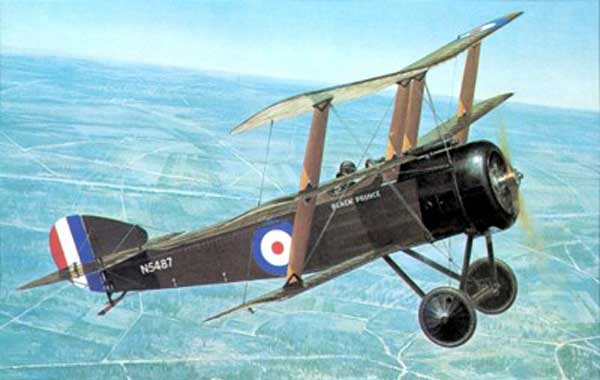
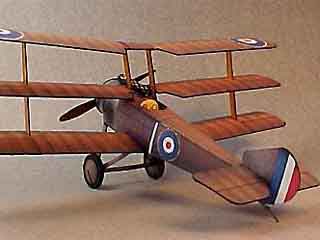
This bold aero dynamical experiment was headed up by Chief Engineer Herbert Smith, who also was also responsible for the Camel.
He chose the unusual triplane formula to create an aeroplane with decreased wing span and increased wing area that would able to dash to 12,000 feet in just 13 minutes!!
The Germans were thrilled with this breakthrough
and had the Tri-winged Fokker Dr-1 flying in a matter a weeks!
I noted what you have said about the Sopwith Triplane, but you have made the same mistake as Antony Fokker, that is to assume that because the tripe could climb fast, that was its intent. The real reason it had three wings was to get better forward lower vision on landing by having thinner wings. Fokker, presuming the fast climb rate was the reason for its manufacture, then tried to copy the fast climb rate but the design he came up with made landing terrible and many German pilots lost their lives as a result. The idea was abandoned in spite of the fast climb rate. The extra weight gave it a poor top speed. As for the Fokker, its reputation outstripped its ability because of Richtofen and others taking a liking to the fast climb rate. Tim Harris 5/06
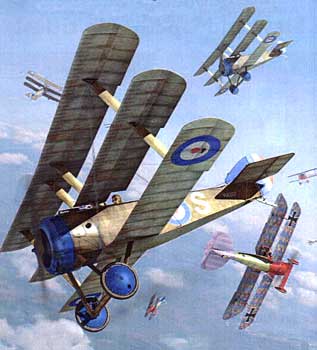
SOPWITH TRIPLANE
The prototype made its first flight on May 28 1916, with Sopwith's test pilot, Harry Hawker at the controls, The compact new aircraft was so impressive that a couple weeks later the test plane was sent to France for operational testing. 400 were immediately ordered by the RNAS (Royal Navy Air Service) for carrier deployment that started in April 1917.
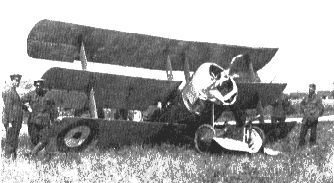 When the Sopwith Triplane was first put into combat, its
clear superiority over contemporary German fighters greatly
alarmed the enemy. About 14 German aircraft companies all
set out to design triplane's to match the Sopwith. The plane's
outstanding qualities were a high rate of climb combined with
maneuverability.
When the Sopwith Triplane was first put into combat, its
clear superiority over contemporary German fighters greatly
alarmed the enemy. About 14 German aircraft companies all
set out to design triplane's to match the Sopwith. The plane's
outstanding qualities were a high rate of climb combined with
maneuverability.
The Sopwith Fighter was also associated with the fame of the Canadian Ace, Raymond Collishaw, who shot down seven enemy planes and damaged another 17 in May and June 1917.
The Triplane's effect on the enemy was clearly summed up by an historian of the period who remarked that 'the sight of a Sopwith Triplane formation, in particular, induced the enemy pilots to dive out of range"
Nevertheless, the Sopwith Triplane had a relatively short combat career, (only 144 were built), and its fame was soon overshadowed by its most illustrious and unpredictable successor, the Sopwith Camel The appearance of the Camel brought production to an immediate halt and the planes began to be withdrawn from front-line service in July 1917. Very few Sopwith Triplane's saw action outside the European theatre.
Only a few were left at the time of the Armistice having been withdrawn from combat and reassigned to flying schools or used experimentally. Sopwith continued to experiment with the triplane formula. Two more triplane's were designed around the new 150 and 200hp Hispano-Suiza engines but never got beyond the prototype stage.
In their search for an outstanding fighting aeroplane the Sopwith experimental department decided in early 1916 to build an entirely new design-a triplane. The completed machine had narrow-chord wings, affording the pilot a good all-round view; at the same time, the combined wing area of the three main planes gave plenty of lift. Ailerons were fitted to all three wings: the interplane struts were plain but strong and few bracing wires were needed. The fuselage was a typical Sopwith wooden box girder. Tailplane, elevators, rudder and fin resembled those of the Pup. but later production models had a tail-plane of reduced area.
The power unit, a 110 h.p. Clerget rotary, was eventually replaced by the 130 h.p. Clerget. The standard armament consisted of a fixed Vickers gun. synchronized to fire through the revolving airscrew; six Triplane's, however. were fitted with twin guns.
In June 1916 the prototype, N500, went to Naval 'A' Fighting Squadron at Fumes in France for service trials. The Triplane was a success from the start and was ordered by both the R.F.C. and R.N.A.S. It was destined to be flown operationally by naval units only; the R.F.C.. who had already received a present of the first sixty R.N.A.S. Spad S.7s. decided in February 1917 to accept the remaining sixty in exchange for the Sopwith Triplane's on order for the Corps.
No. 1 (Naval) Squadron, 'Naval One', went into action with the type in April 1917. in support of the hard-pressed R.F.C. The hitherto very successful Albatros D-III was completely outclassed, and Id Flieg. the German Inspectorate of Flying Troops, received a severe shock. The 'Tripehound' told out-climb and out-turn the Albatros, and was 15 m.p.h faster.
Naval Eight and Naval Ten, equipped in April and May. also made their presence felt. Proof of the Triplane's worth was soon to hand. In April 1917 Flight Commander R. S. Dallas and Flight Sub-Lieutenant T. G. Culling attacked a formation of fourteen German aircraft. After forty-five minutes they had shot down three of the enemy and driven the remainder into retreat.
Other famous R.N.A.S. pilots who scored heavily with the type were Collishaw, Little. Booker. Reid, Sharman. Nash and Alexander.
One 'Tripe', N543 1. reached Macedonia and eventually operated from Mudros in the Aegean Sea. Another. No. N5486. went to Russia and was eventually provided with skis for operating in the snow.
Some difficulty was found in obtaining spares for the Triplane during the summer of 1917. And one unit, Naval One, had to reduce its establishment from eighteen to fifteen aeroplanes. By the autumn the type had passed its zenith and the rate of casualties in Triplane squadrons rose.
The last operational Triplane's were exchanged for Camels in November 1917. When it is realized that only about 150 were built, it is surprising how much they influenced the trend of design. A host of triplane's and quadruplanes were built by the leading German and Austro-Hungarian aircraft manufacturers in efforts to match the performance of the remarkable Sopwith Triplane.
Raymond Collishaw
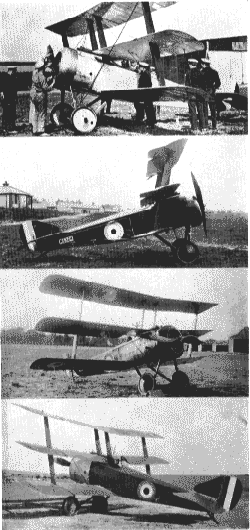 THIRD on the list of British aces, second to WA
Bishop as Canada's greatest fighter pilot and the top naval ace of
World War I, Raymond Collishaw in addition was leader of one of the
most famous Allied fighter units of the war- the 'Black Flight' of
Sopwith Triplane's.
THIRD on the list of British aces, second to WA
Bishop as Canada's greatest fighter pilot and the top naval ace of
World War I, Raymond Collishaw in addition was leader of one of the
most famous Allied fighter units of the war- the 'Black Flight' of
Sopwith Triplane's.
He was born in Nanaimo, British Columbia, on 22 November 1893. While still in his teens he served as second mate on a tramp steamer and in 1911 he sailed with Scott to the Antarctic. By 1914 his taste for adventure had not been quelled and from Canada's Fishery Protection Service he transferred to Britain's Royal Naval Air Service at his own expense and by the beginning of 19 i6 was a qualified pilot assigned to coastal patrol duty. On 2 August 1916 he joined No 3 Wing RNAS, the so-called 'Sopwith Sailors', who were constituted at Luxeilles-Bains with a motley collection of equipment to make strategic bombing raids on the German industries of the Saarland.
On 12 October 1916 the wing set out to attack the Mauser Waffenfabrik at Oberndorf. Collishaw flying a single-seat Sopwith is-Strutter escorted an Anglo-French bombing force of 24 aircraft on the 223 mile round trip and saw off a Fokker DII that attacked the formation. On 25 October he downed two more of the same type over Luneville while ferrying a new aircraft from the wing's field at Luxeil.
On February i 917 he was transferred to No 3 (Naval) Squadron at Marieux flying Sopwith Pups commanded by another Canadian, Sqn Cdr R H Mulock. On 4 March Collishaw claimed an Albatros DIII, and one week before the Battle of Arras opened, Collishaw went to No io (Naval) Squadron at Fumes on the Flanders coast to take command of 'B' Flight. He was newly promoted Flight-Commander and hand-picked four other redoubtable Canadians to follow him. They were to become one of the most successful units of the war.
At the core of 'Naval Ten' were the five Canadians, Collishaw himself, Flt Sub-Lts Ellis Reid of Toronto, J E Sharman from Winnipeg, J E Nash of Hamilton and M Alexander of Montreal-all of them in their early twenties. They flew the Sopwith Triplane's of the ominously named 'Black Flight'- the engine cowling, wheel disc covers and metal forward fuselage decking all being painted black with the names in white lettering: Black Maria, Black Death, Black Sheep, Black Roger and Black Prince of Collishaw, Sharman, Nash, Reid and Alexander.
While the RFC's aerial offensive above Arras was breaking bloodily against the Albatros Jastas,~in the area around Dunkirk where Naval Ten operated with its Triplane's, it was a different story. While these formidable fighting machines were being used to protect the Channel approaches, the RFC squadrons to the south were being decimated. On 28 April Collishaw caught a Roland over Ostend and scored three more times during the first twelve days of May while patrolling the coast. Meanwhile reports of this strange three-winged fighter that could perform outstanding aerobatic feats were filtering down to the embattled squadrons, both British and German to the south.
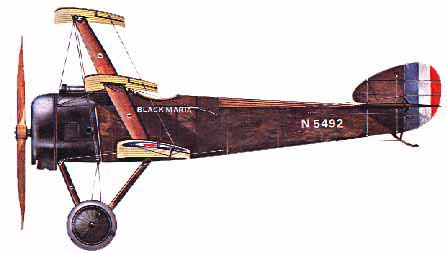
Finally on I June 1917 Naval Ten was drawn into the battle and put under No ii Wing RFC stationed at Droglandt. Immediately the black nosed triplane's made their presence felt. Four enemy aircraft went down before Collishaw's guns in five days. On 5 June he brought his score to thirteen with the destruction of an Albatros two seater.
On 6 June he shot down three Albatros Dills in the course of one action and for this feat he was awarded the DSC; he was gazetted on 20 July 1917. On 15 June Collishaw shot down three Halberstadt D-types and an LVG two-seater bringing his victory total to twenty-three.
By now the Jastas who had had it their own way for so long were alarmed. Ground observers were urgently alerted to look out for the three-winged aircraft and Jasta 11 was given priority orders for their destruction. On 25 June the rival formations met over Quesnoy and the German veterans found the Sopwith's as slippery in the air as they had been led to expect. Only Leutnant Karl Allemenroder, von Richthofen's deputy, scored a victory shooting down Nash in Black Sheep.
The Germans however were shaken. Allmenroder split the Jasta in two attempting to build a tactical trap to ensnare the Black Flight but his plan went wrong and the lower formation was caught by Collishaw before the German top cover could pounce. Black Maria cut Allmenroder's green and white Albatros DIII away from his formation and with a burst of fire sent Jasta ii's deputy commander diving into Lille's outskirts.
For the first three weeks of July the indomitable Canadians continued to maul the Germans. On 6 July Richthofen himself was shot down and wounded by the gunner of an FE2d fighting in a defensive circle until Collishaw himself arrived with four Triplane's and drove away the attackers without loss to themselves.
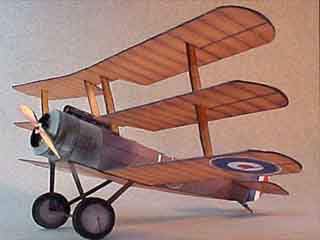 |
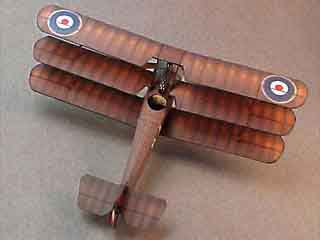 |
By 28 July his score was thirty-seven and he was sent back to Canada for two months' leave. On his return to France on 26 November after a brief spell as an instructor he joined the RNAS Seaplane Defense Station at St Pol as 'A' Flight Commander. On 29 December 1917 he was given command of the unit now re titled No 3 (Naval) Squadron equipped with a formidable new aircraft again from the Sopwith stable. The experienced Collishaw quickly learned the unforgiving habits of the Sopwith Camel and dispatched two seaplanes and an LVG. At the end of January Collishaw, took over No 3 (Naval) Squadron, another Camel unit based at Bray-Dunes near Dunkirk.
When Ludendorff's great offensive opened in March the unit was at Mont St Eloi, near Arras but Collishaw himself was tied up with administrative duties. On April however when the RAF was formally constituted, he was commissioned as a Major and placed in command of the Camel-equipped No 203 Squadron. In June he was back in action and through the next four months while up against the formidable last generation of German fighter aircraft he scored twenty more victories including ten Fokker DVIII's. On October 1918 he was promoted Lieutenant Colonel and was only twenty-five years old. He was withdrawn from the front line and joined the other famous Canadian airmen like Bishop and McKeever who at the time were laying the administrative foundations for a Royal Canadian Air Force.
The November Armistice was not the end of the air combat however for Raymond Collishaw. In July 1919 the No 47 Squadron RAF under his command was sent to southern Russia to aid the White General Denikin against the Red Army. Here he scored more victories including an Albatros DV.
Raymond Collishaw's sixty-two victories included forty-two destroyed (and one shared) and nineteen seen to go down out of control. This great Canadian ace also had over 100 indecisive fights in which a further fifteen aircraft were driven down but not claimed.
|
The prototype made its first flight on May 28 1916, with Sopwith's test pilot, Harry Hawker at the controls, The compact new aircraft was so impressive that a couple weeks later the test plane was sent to France for operational testing. 400 were immediately ordered by the RNAS (Royal Navy Air Service) for carrier deployment that started in April 1917. When the Sopwith Triplane was first put into combat, its clear superiority over contemporary German fighters greatly alarmed the enemy. About 14 German aircraft companies all set out to design triplane's to match the Sopwith. The plane's outstanding qualities were a high rate of climb combined with maneuverability.
The Sopwith Fighter was also associated with the fame of the Canadian Ace, Raymond Collishaw, who shot down seven enemy planes and damaged another 17 in May and June 1917. |
The Triplane's effect on the enemy was clearly summed up by an historian of the period who remarked that 'the sight of a Sopwith Triplane formation, in particular, induced the enemy pilots to dive out of range" Nevertheless, the Sopwith Triplane had a relatively short combat career, (only 144 were built), and its fame was soon overshadowed by its most illustrious and unpredictable successor, the Sopwith Camel The appearance of the Camel brought production to an immediate halt and the planes began to be withdrawn from front-line service in July 1917. Very few Sopwith Triplane's saw action outside the European theatre. Only a few were left at the time of the Armistice having been withdrawn from combat and reassigned to flying schools or used experimentally. Sopwith continued to experiment with the triplane formula. Two more triplane's were designed around the new 150 and 200hp Hispano-Suiza engines but never got beyond the prototype stage. |
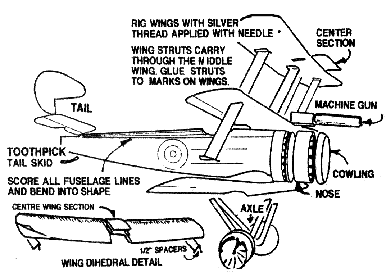
Specifications for the Sopwith Tripe
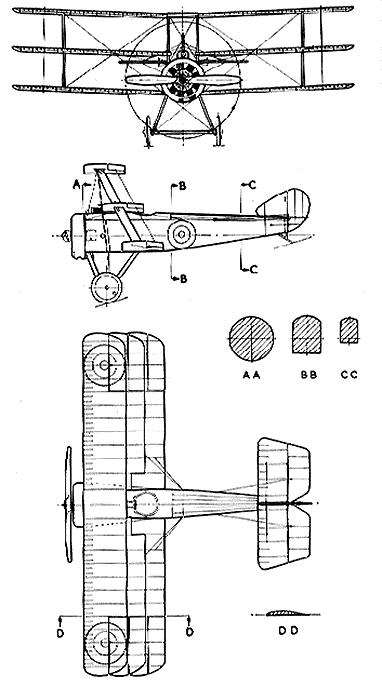 |
Length: 18 ft 10 in Wingspan: 26 ft 6 in Height: 10 ft 6 in Wing area: 231 ft² Empty weight: 993 lb Loaded weight: 1,415 lb Powerplant: 1× Clerget 9B rotary engine, 130 hp Performance Maximum speed: 117 mph at 5,000 ft Range: 280 mi Service ceiling: 20,500 ft Wing loading: 6.13 lb/ft² Endurance: 2 hrs 45 min Time to altitude: 6.33 min to 6,500 ft |
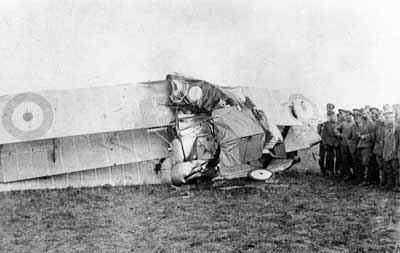 |
| Sopwith Triplane N5421 crashed 26.09.17 J.C. Akester Naval 1 (survived) |


